
People Also Ask in 2020
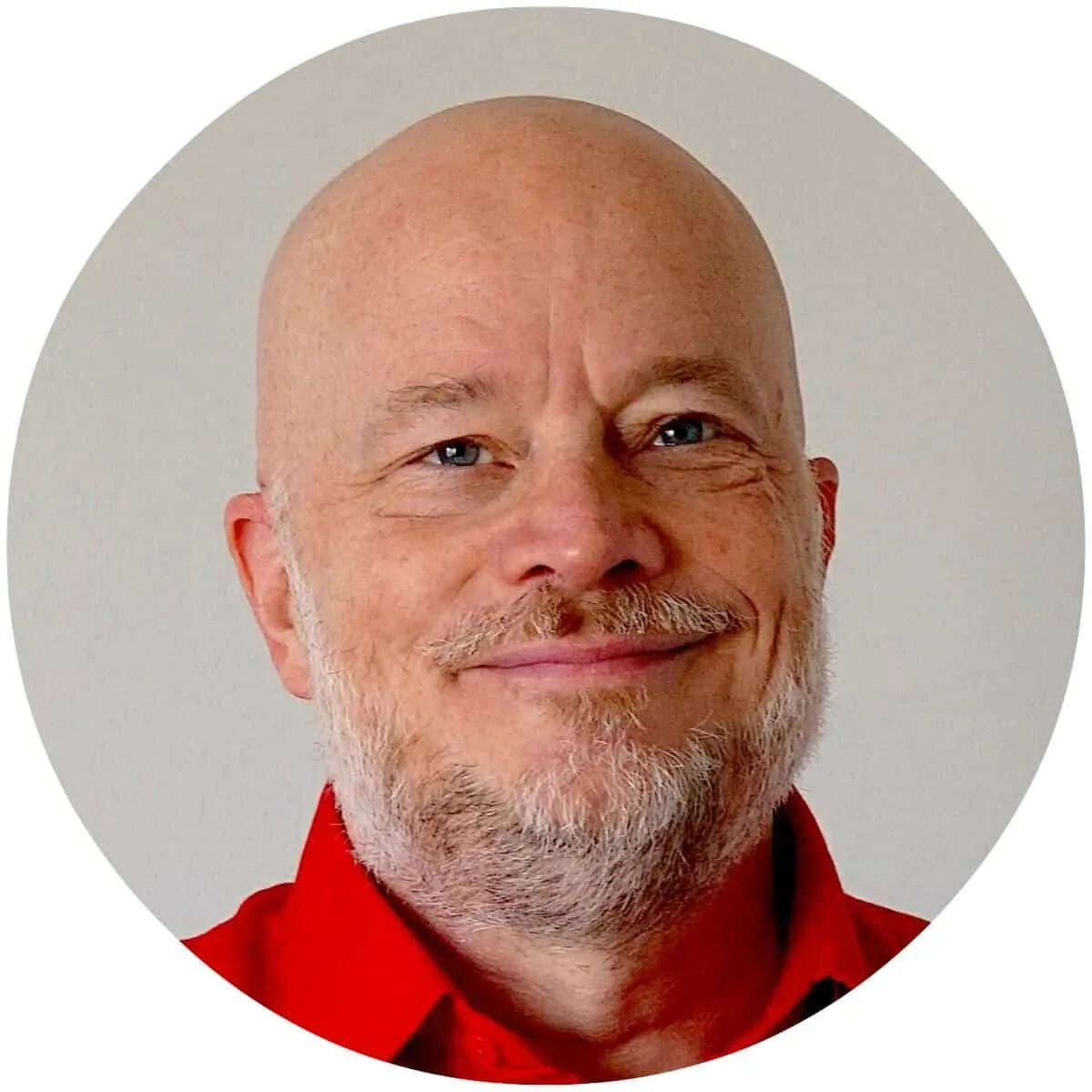
Jason Barnard
March 11, 2020
People Also Ask in 2020
Google is trying to provide answers. It does this in an increasing number of ways. Rich elements like the featured snippets – the ‘best’ answer pulled from third-party sites – and knowledge panels that show information Google has in its Knowledge Graph.
Answers on the SERP
Google is giving the answer right there on the search results page (SERP). It’s aim here is to improve it’s users’ experience by providing the best available answer directly, with little or no need to click through to the site providing the information.
When the full answer is provided right there on the SERP, that is a great experience for Google’s users – they get the answer to their question quickly and efficiently from a source they trust (Google).
But for site owners who provide these answers that means the user doesn’t visit their site. The fact that the user does not click through to the site is a lost opportunity for the brand to tag the user for remarketing and a lost opportunity to present the brand and its offers in detail. All that’s left is an opportunity for branding.
Here is an example of a question that requires only a short answer. Google is showing the full answer on the SERP, the user has no need to visit the site – a so-called ‘no-click’ search.

AccuRanker Feature – If you need to know how many of your target keywords have a featured snippet – and better yet – how many your website appears in, you don’t have to check this manually (and it would be impossible to do this for multiple locations).
You can now get a complete overview of all SERP features in AccuRanker’s Aggregated SERP Analysis tab. There you can see exactly which SERP features are visible for your keywords and the percentage you own of each SERP feature.
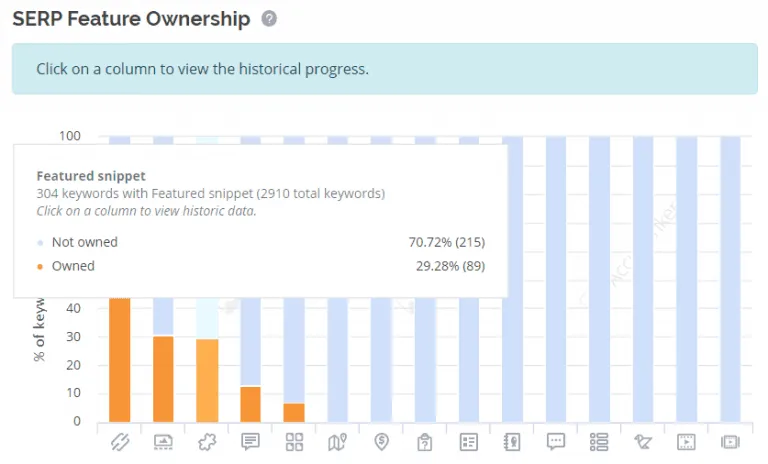
You can further analyze each SERP feature by clicking on the column and see how it has changed over time in the SERP Feature History graph. This helps you measure any impact from changes you make, and identify new opportunities of underutilized features in Google search.
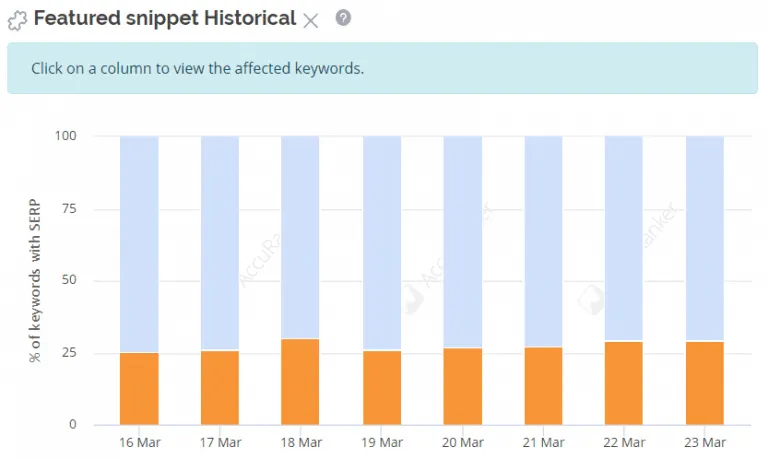
Questions on the SERP
In addition to Featured Snippets, Google is increasingly taking that a BIG step further by suggesting possible next steps for the user in their search journey, aka related questions, aka People Also Ask.

On the SERP, these questions often replace a traditional blue link (I call that ‘killing a blue link’), which reduces the number of results on Page 1, and reduces the opportunity for brands to rank there for the user’s search query. They take up quite a lot of space, and the visible part of the PAA (People Also Ask) box offers nothing to the sites that appear there… not even brand visibility.
The user has to click on the question to see anything more… and then, if it can, Google will display the whole answer.

Once again, the opportunity here is limited brand awareness, and very limited traffic, since it requires that the person clicks on the question, then on the link to the full answer. Reliable clickstream data for that is not available at this time, unfortunately.
PAA boxes are extremely common – currently appearing on half of all SERPs (see the figures below)… and they are becoming more common – in just 12 months, their presence has jumped by a third.
AccuRanker Feature – You can easily find out how many of your keywords include a “Related Questions” (People Also Ask) box in the Aggregated SERP Analysis tab in AccuRanker. The Total SERP Feature Overview tells you exactly the percentage of each SERP Feature over all your keywords. You can also see the change over time in how many keywords include a PAA, and see exactly which keywords those are, to identify new opportunities.
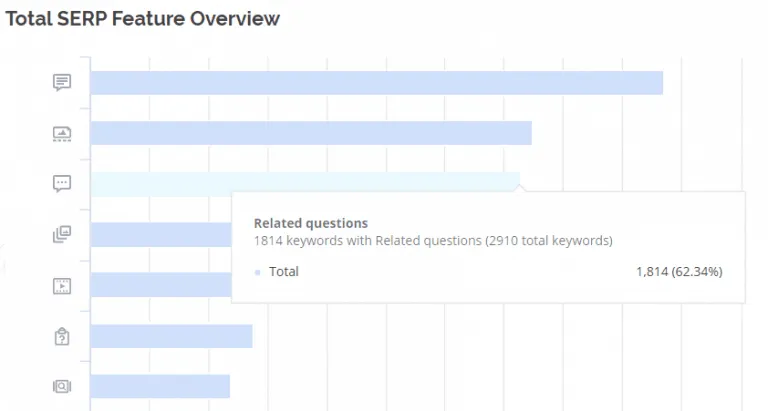
Search Queries as explicit or implicit questions
Before we start with the facts and figures, a quick explanation. Although most people don’t phrase their search queries as such, every search on Google is a question… when we search on Google our intention is to find the solution to a problem or the answer to a question, whether we formulate that question explicitly or not.
Ambiguous queries are implicit questions and Google’s problem is understanding “which question is the user asking”.
For example, the ambiguous search query “house”, the user can be asking:
- Where can I buy a house?
- Where can I sell my house?
- Where can I rent a house?
- How do I sell my house?
- How do I go about buying a house?
- What is the definition of “house”?
- Where can I find a picture of a house?
- Where can I watch the TV show Dr. House?
- Which actor plays Dr. House?
- Where can I find House music?
… and hundreds more
Google’s ability to understand what the question behind the query is vital to its capacity to provide results that satisfy the user by providing the best answer.
Google introduced RankBrain in early 2015. Rankbrain’s role is to better understand the intent of the search query – to more reliably extract the hidden question behind ambiguous searches.
This enhanced ability to ‘guess the hidden question’ has led to significant changes in Google’s results.
It has allowed Google to provide more relevant results
Better understanding the questions allowed Google to provide a better list of potential answers. With ‘understanding the question’ comes the capacity to show only relevant answers, rather than a list of possibilities that cover multiple interpretations of the intent of the query.
When it CAN disambiguate (guess the implicit question behind the query), then Google can provide significantly better results… and potentially the one single ‘best’ answer.
It has allowed Google to provide more direct answers
If Google has identified a ‘best answer’ (their words, not mine), then it can show that as a featured snippet or knowledge panel. But to show a ‘best answer’ it must first correctly understand the question.
With explicit questions (how, what, why, where, who), that is possible and reasonable. With an ambiguous query where Google is unable to guess the real intent, it has no chance of showing an ‘answer’ in the form of a featured snippet. With an enhanced capacity to ‘understanding the question’ comes increased opportunities to show a ‘best answer’.
We first saw Featured Snippets in early 2014, before the official announcement of RankBrain… even if RankBrain was not directly the technology that allowed Google to roll out this feature, it is safe to say RankBrain has been the driving force behind the rapid expansion of Featured Snippets when a user does not ask a question explicitly.
It has allowed Google to suggest more relevant follow-up questions to the user
After answering a question, the next logical step is suggesting follow-up questions with the answer to those… hence the birth of People Also Ask in early 2015 at around the same time as RankBrain was announced.
Today, an explicit question almost always triggers a list of follow-up questions (aka People Also Ask) – 85% of the time, as we see below. But as RankBrain improves and gets better at identifying the hidden question behind the query, Google can show PAA / related questions on SERPs for more and more ambiguous search queries.
The numbers we found for 2019 show that this is what is happening. And common sense tells us that this is very likely to continue since RankBrain will continue to improve over time.
Now for the numbers
We analyzed the SERPs for 5 million queries in the UK Feb 2019 to Feb 2020. We identified 4 SERP types – informational, navigational, purchase and geo.
- Informational = explicit questions – how, why, what, when…
- Navigational = brand names
- Purchase = includes words such as – buy, price, cheap…
- Geo = contains geo words such as – near me, where…
- Other = any search queries that do not fit into one of the first 4
PAA / related questions presence and growth by device in 2019
It is striking that the numbers are very similar for desktop and mobile both in terms of the percentage of SERPs that contain PAA, and also the growth over the year.
Half of all SERPs have PAA boxes – a growth of over 20% year on year. Google sees these suggested questions as enhancing user experience on all types of search intent.
This would suggest that RankBrain is indeed improving and that Google is increasingly able to identify the question, even when the user does not explicitly ask one.

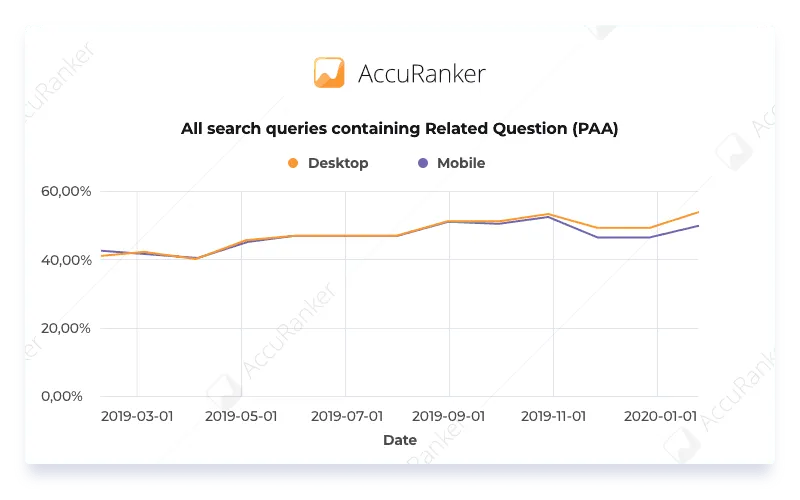
PAA growth by search intent in 2019
Now let’s break that down by search intent. The differences are striking. And also very logical…. From the perspective of Google aiming to best satisfy its users.
Search queries with Informational intent
Search queries with informational intent – explicit questions – almost all have PAA boxes (85%). Providing possible follow-up questions to the initial question is relatively simple, logical and helpful to the user.
Growth here has been small. Even at the start of 2019, the percentage of explicit questions that triggered potential follow-up questions was very high. Logical since the question behind this type of query is the most easily understood, and always has been.
This percentage is likely to grow a little more through 2020 as RankBrain continues to improve but it is probably approaching it’s ceiling.
Mobile and desktop started, and remain, pretty much neck and neck here.


Search queries with Purchase intent
With queries that have purchase intent, the ‘hidden question’ is fairly obvious, as are the next potential steps. The presence started the year lower than for informational queries but has now caught up – also sitting at around 85%.
This percentage is likely to grow a little more through 2020 as RankBrain continues to improve, but it is also probably approaching it’s ceiling.
Interesting to note that a year ago desktop was lagging quite far behind mobile, but pretty much caught up at the start of 2020.
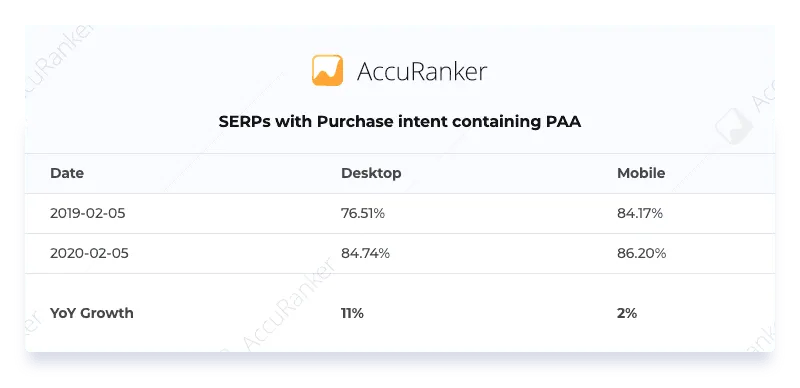
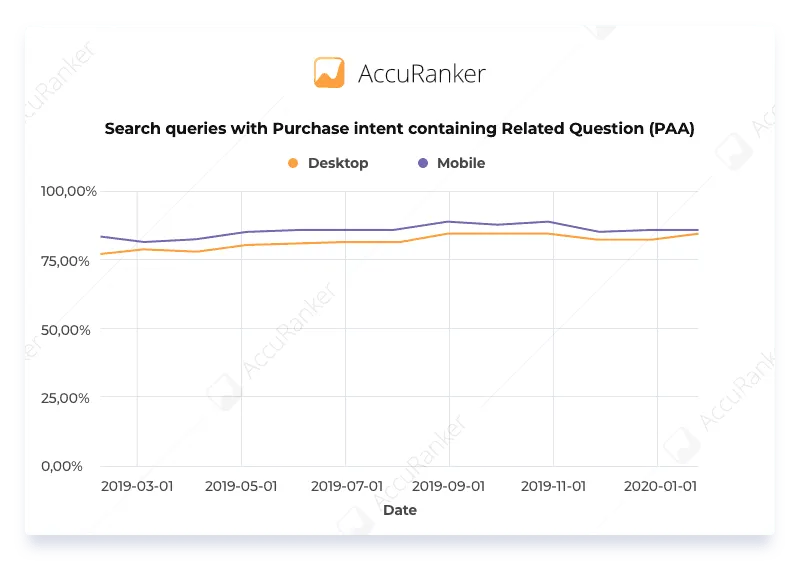
Search queries with Geo intent
With a geo-intent query, the implicit question is less obvious than for informational and purchase, but the geo-context remains a strong clue… especially on mobile.
Interestingly, the presence of PAA on desktop rose significantly at the start of 2019 (up 15%), and then over the course of the year overtook mobile. This suggests that Google is now very local-focused, even when the user is not on-the-go.
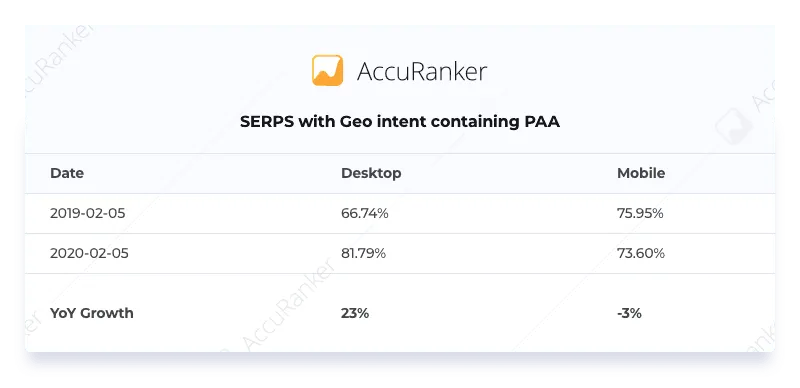
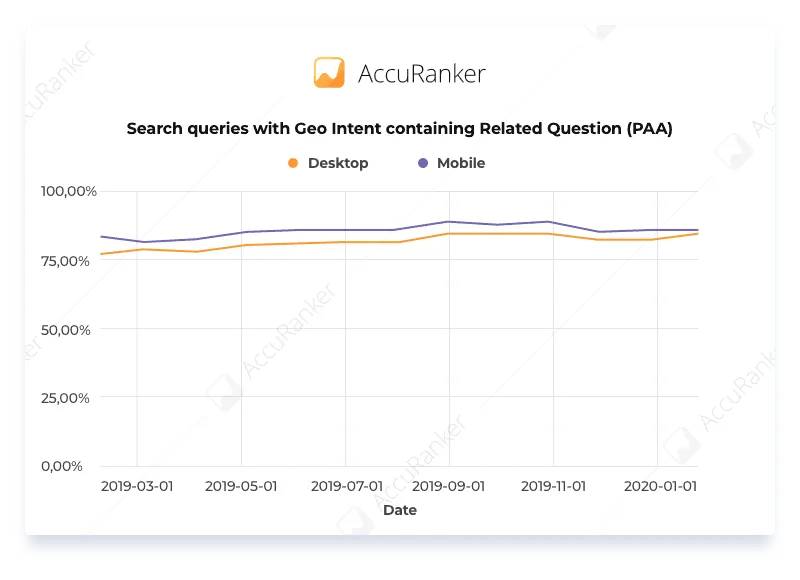
Search queries with other (or no) intent
This was the majority of the data we tracked (69% of the 5 million), and so no real surprise here – the figures run parallel to the overall figures. What this does show us is that even when the user provides no explicit intent, Google is confident it has understood the question hidden in the search query 50% of the time. That is impressive.
And Google is getting better. Fast. We see a lot of growth here – My analysis is that RankBrain is getting better at finding the question hidden behind ambiguous search queries, so Google can show results that contain relevant follow-up questions more often.
The huge growth year-on-year – 27% on desktop and 16% on mobile – indicates just how fast Google is improving its capacity to understand the ‘hidden’ questions its users are asking.
Expect this to grow further in 2020. I’ll stick my neck out and predict over 60% by year’s end.
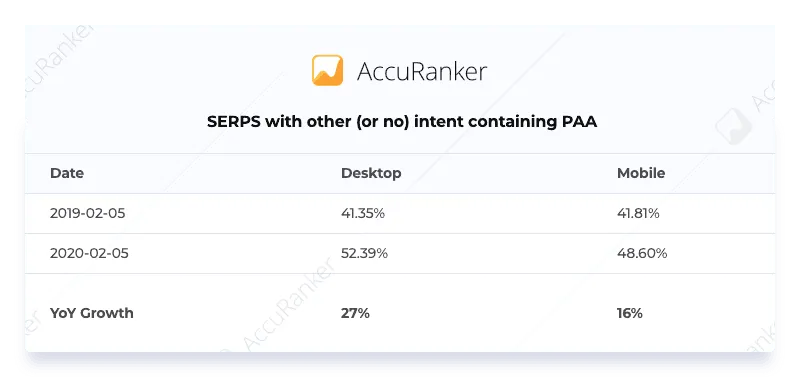
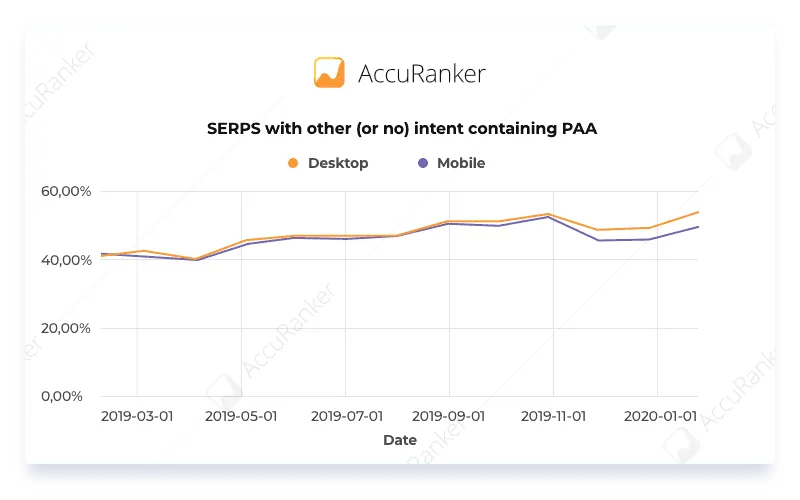
Search queries with Navigational intent
When a user is searching an exact match brand name (I call these results “Brand SERPs”), they are navigating to, or researching that brand. So the vast majority of people using these search terms are asking one of two questions
- “Where is the site of {brand}”
- “What can you tell me about {brand}”
And Google has to cater for both.
In the first case (when a user wants to simply navigate to the brand’s website), there are no obvious follow-up questions – PAA is not really helpful to these people.
If they are researching the brand, then follow-up questions are pertinent and helpful for them. They are in research mode, and that carries lots of possible follow-up questions – about the brand and about its products… but also questions around its expertise, and (ominously) about the competition.
Seems simple at first glance. However, to provide truly relevant follow-up questions around the brand, Google has an extra hurdle to overcome… it needs to be confident that it has correctly understood what the brand is and what it does. That means understanding the brand and its offers as entities (in the Knowledge Graph – read more here). And that is something Google has been struggling with. That explains the low, low figures we see here at the start of 2019.
But what explains the phenomenal growth (71% on desktop and 39% on mobile) that far and away outpaces the growth of any other intent?
For me, this clearly indicates that in 2019 Google pushed its Knowledge Graph forward with a GIANT step (read more here). It is now confident it has correctly understood a larger number of brands and their offers… and is therefore much more willing to suggest related questions about that brand and its offers when a user searches the brand name.
And that goes further. It would seem that Google is relying more and more on the Knowledge Graph to drive an increasing number of its rich SERP features – Knowledge Panels (obviously), but also PAA, Related Search, People Also Searched For, Events, Podcasts… and many more.

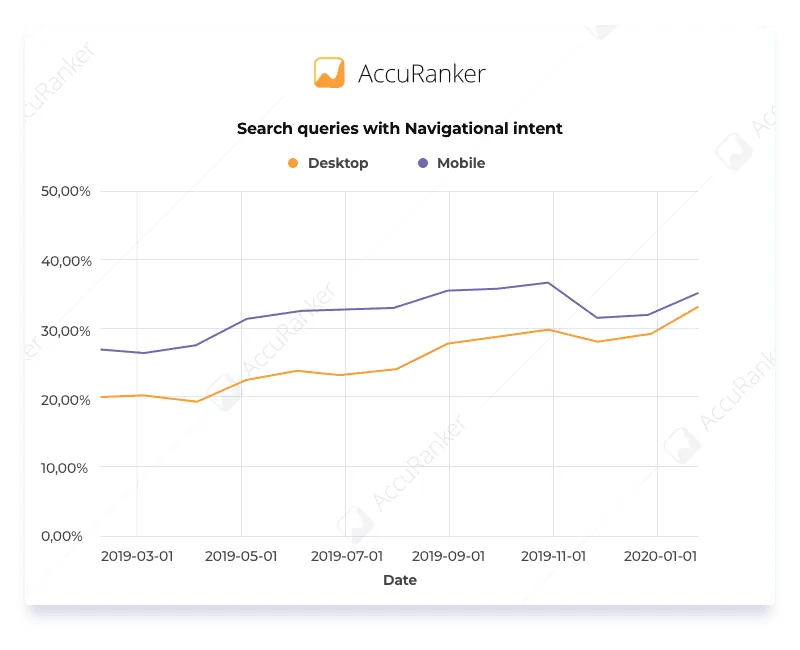
Supporting evidence from Kalicube. pro
I have specialized in Brand SERPs for several years. I have been tracking and analyzing the Brand SERPs for 7,504 brands, including all the rich elements they contain. The data I have collected supports AccuRanker’s – in February 2020, we see 33% of Brand SERPs with PAA.
(By the way, you can track your brand SERP for free with Kalicube.pro here).
Conclusion - PAA / Related Questions are here to stay
In early 2020, PAA hit an important landmark – when users search, they see these follow-up questions over 50% of the time. That makes them one of the most common and visible elements on Google.
They are not an obvious ‘win’ for your SEO strategy – the brand visibility is limited to when the user opens the question. So you’re giving your content to Google for it to display to its users directly. No click. And not even any brand visibility if the users don’t click on a question.
But Google is not going to change tactic, so they are here to stay and will almost certainly expand over the coming years. If you ignore them, you miss an opportunity that your competitors may well take. You really have to play the game.
Next steps
Firstly, occupy that space to keep your competitors off. Take the (limited) brand visibility these PAA provide. Start tracking the questions that appear on relevant SERPs – provide the answers to get the spots where you can, either in pages that you already have, or by creating new pages. The ‘win’ you get through the People Also Ask is perhaps not immediately attractive, but here’s a “secondary” win that is.
When you answer specific questions accurately and pertinently (and get the PAA) you may well rank top on the SERP for that keyword/search query… and potentially for multiple closely related queries and questions. And those give visibility and bring qualified traffic – potential clients.
About the Author
Jason Barnard (The Brand SERP Guy)
Jason has over 2 decades of experience in digital marketing. He started promoting his first website in the year Google was incorporated and built it up to become one of the top 10,000 most visited sites in the world (60 million visits in 2007).
Today he is a full-time 100% digital nomad, host, and keynotes speaker at conferences around the world, whilst interviewing industry experts for his podcast – “With Jason Barnard… The smartest people in marketing talk to Jason about topics they know inside out. The conversations are always intelligent, always interesting… and always fun!”.
Brand SERPs
Why “The Brand SERP Guy”? Because Jason has been studying, tracking, and analyzing Brand SERPs (what appears when someone Googles your name) since 2014…
Conclusion: Brand SERPs is your new business card, a reflection of your brand’s digital ecosystem, and an honest critique of your online marketing strategy. That could well be enough to pique the interest of any marketer and any brand… in any industry 🙂
News: Jason has released a series of online courses that teach brand owners and marketers to optimize their brand SERPs.
Where can you find Jason Barnard?
Related blog posts
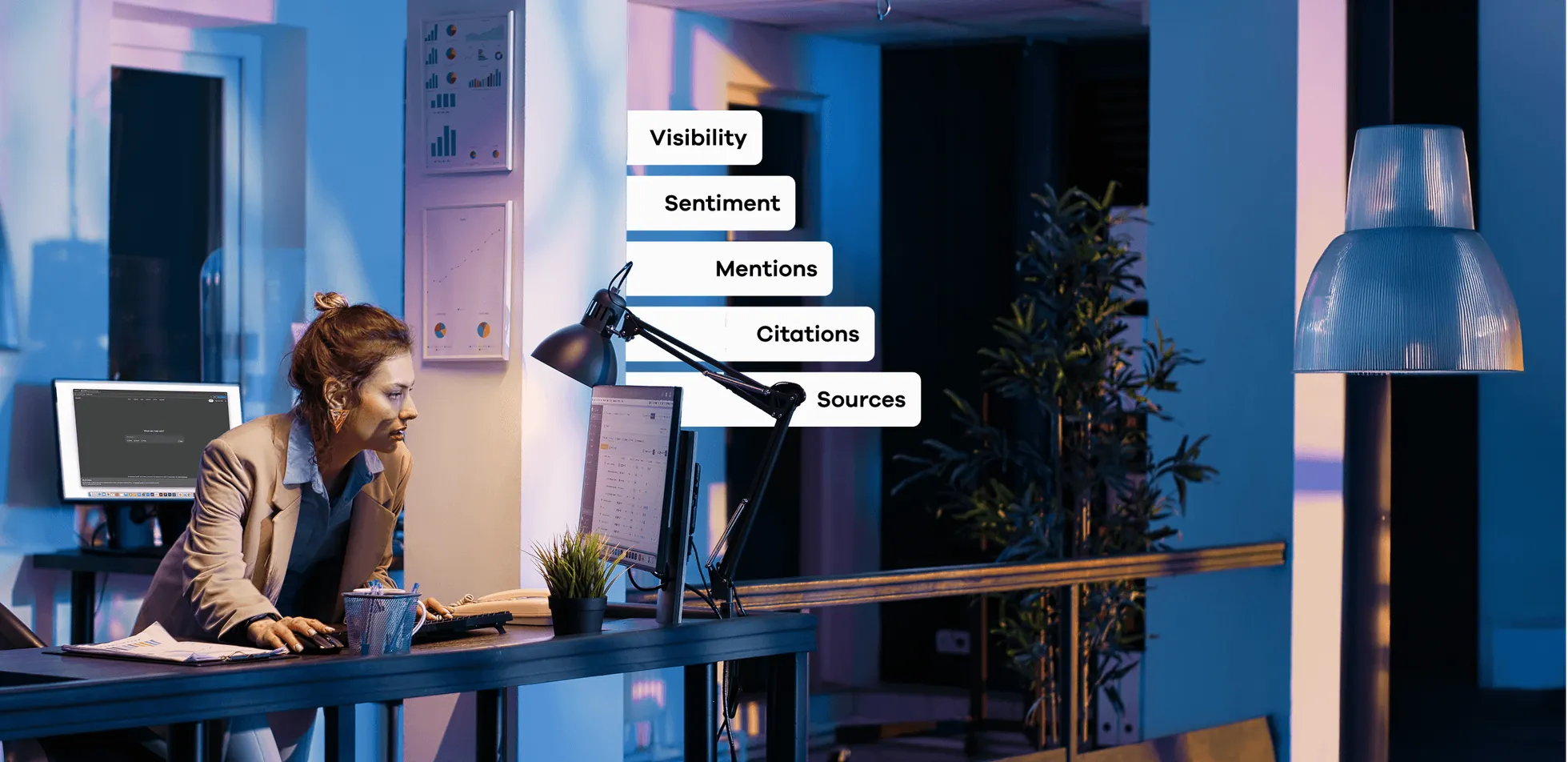
5 LLM Visibility Metrics You Should Track in 2026
SEO is now both about ranking in search engines and being visible in LLMs. We give you five visibility metrics every SEO should track in 2026.
3 December 2025Is LLM Tracking Relevant for You?
LLM tracking is not just for SEOs. It is also relevant for content teams, agencies, marketing leadership, and communication teams. Learn why here.
26 November 2025
How to Find the Best Prompts to Track for AI Visibility
Do you want to start tracking prompts to optimize your AI visibility? We give you seven practical ways to identify relevant prompts to track in LLMs.
9 November 2025
